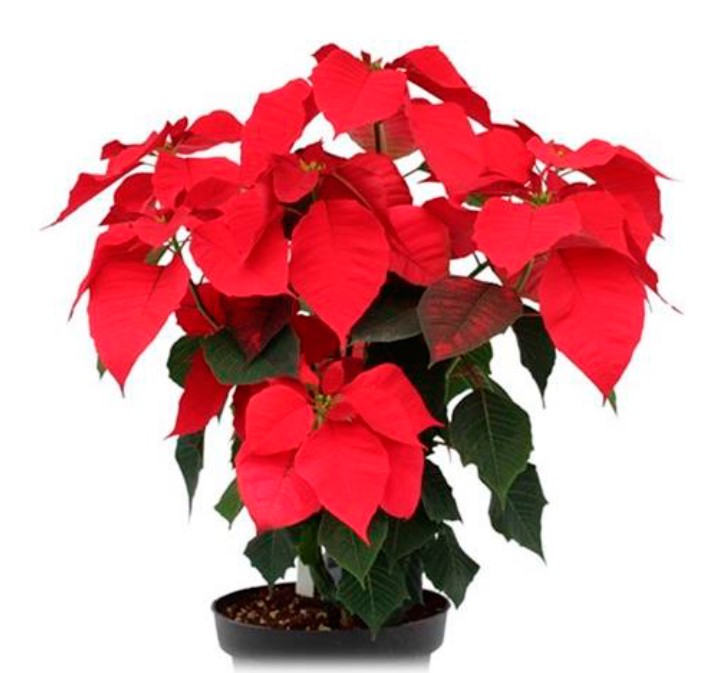New Mexican variety of poinsettia called Victoria
DOI:
https://doi.org/10.29312/remexca.v13i4.2331Keywords:
aesthetic attribute, bract, leaf, plant sizeAbstract
The state of Morelos is characterized by the diversity of ornamental species that are grown and marketed both in the national and international market. In Mexico, approximately 20 million plants finished in different container sizes are marketed annually, with a production value of 718 million. Genetic improvement programs for cultivated species run by government agencies are scarce. The largest proportion is carried out by foreign private companies. Poinsettia is subjected to the same model. Faced with this situation, the National Institute of Forestry, Agricultural and Livestock Research launched the Poinsettia Genetic Improvement Program in the Experimental Field of Zacatepec, Morelos. The poinsettia variety called Victoria is a product of this program and was generated through hybridization, selection and grafting technique. Victoria is an intermediate plant with medium branching and width. The outstanding attributes of this variety are the oval shape of the leaf, the size of the leaf and the absence of lobes. The shape of the base of the leaf is rounded. The bracts are elliptical in shape, red in color and of intermediate size. The width of the cyme and the size of the gland are medium. It is considered an intermediate cycle variety. The response of Victoria is statistically comparable to commercial varieties and represents an option for the country’s producers in order to diversify the offer in the Christmas season.
Downloads
References
Canul, K. J.; García, P. F.; Osuna, C. F.; Ramírez, R. S. y Barrios, G. E. 2013. Recursos genéticos de nochebuena en México, colecta de germoplasma para mejoramiento genético. Ciencia y Tecnología Agropecuaria de México. 1:20-26.
Canul-Ku, J.; García-Pérez, F.; Barrios-Gómez, E. J.; Campos-Bravo, E.; Osuna-Canizalez, F.; Ramírez-Rojas, S. G. y Rangel-Estrada, S. E. 2015. Técnica para producir híbridos en nochebuena (Euphorbia pulcherrima Willd. ex Klotszch). Agroproductividad. 8:32-37.
Canul-Ku, J.; García-Pérez, F.; Barrios-Gómez, E. J.; Rangel-Estrada, S. E.; Ramírez-Rojas, S. G. y Osuna-Canizalez, F. 2017. Variación generada mediante recombinación genética en Euphorbia pulcherrima Willd. ex Klotszch. Agroproductividad. 10:13-17.
Canul-Ku, J.; García-Pérez, F.; Barrios-Gómez, E. J. y Rangel-Estrada, S. E. 2018. Formación de híbridos clonales en nochebuena (Euphorbia pulcherrima Willd. ex Klotszch). Rev. Fitotec. Mex. 41:311-316.
García-Pérez, F.; Rangel-Estrada, S. E.; Canul-Ku, J.; Osuna-Canizalez, F.; Ramírez-Rojas, S. G. y Portas-Fernández, B. 2017. Técnicas de injertos entre genotipos de Euphorbia pulcherrima Willd. ex Klotszch. Agroproductividad. 10:18-23.
García, P. F.; Rangel, E. S. E.; Barrios, G. E. J.; Ramírez, R. S. G.; Portas, F. B. y Canul, K. J. 2019. Leticia: nueva variedad mexicana de nochebuena para interiores. Rev. Mex. Cienc. Agríc. 10:461-466. DOI: https://doi.org/10.29312/remexca.v10i2.1366
Islam, M. A. and Joyce, D. C. 2015. Postharvest behavior and keeping quality of potted: a review. Research in Agriculture, Livestock and Fisheries. 2:185-196. DOI: https://doi.org/10.3329/ralf.v2i2.24991
Márquez-Márquez, J. M.; Canul-Ku, J.; Sánchez-Abarca, C.; Barrios-Gómez, E. J.; García-Pérez, F. y López-Herrera, E. 2017. Evaluación de progenies de cruza doble de flor de nochebuena (Euphorbia pulcherrima Willd. ex Klotszch) en Morelos, México. Interciencia. 42:388-392.
SIAP. 2018. Sistema de Información Agroalimentaria y Pesquera. Anuario estadístico de la producción agrícola. Secretaría de Agricultura y Desarrollo Rural (SADER). Ciudad de México. https://nube.siap.gob.mx/cierreagricola/.
Taylor, J. M.; López, R. G.; Currey, C. J. and Janick, J. 2011. The poinsettia: history and transformation. Chronica Hortic. 51:23-28.
UPOV. 2008. Unión para la Protección de los Organismos Vegetales. Flor de Pascua, Euphorbia pulcherrima Willd. ex Klotzsch. Directrices para la ejecución del examen de la distinción, homogeneidad y estabilidad. Ginebra, Suiza. 36 p.

Published
How to Cite
Issue
Section
License
Copyright (c) 2022 Revista Mexicana de Ciencias Agrícolas

This work is licensed under a Creative Commons Attribution-NonCommercial 4.0 International License.
The authors who publish in Revista Mexicana de Ciencias Agrícolas accept the following conditions:
In accordance with copyright laws, Revista Mexicana de Ciencias Agrícolas recognizes and respects the authors’ moral right and ownership of property rights which will be transferred to the journal for dissemination in open access. Invariably, all the authors have to sign a letter of transfer of property rights and of originality of the article to Instituto Nacional de Investigaciones Forestales, Agrícolas y Pecuarias (INIFAP) [National Institute of Forestry, Agricultural and Livestock Research]. The author(s) must pay a fee for the reception of articles before proceeding to editorial review.
All the texts published by Revista Mexicana de Ciencias Agrícolas —with no exception— are distributed under a Creative Commons License Attribution-NonCommercial 4.0 International (CC BY-NC 4.0), which allows third parties to use the publication as long as the work’s authorship and its first publication in this journal are mentioned.
The author(s) can enter into independent and additional contractual agreements for the nonexclusive distribution of the version of the article published in Revista Mexicana de Ciencias Agrícolas (for example include it into an institutional repository or publish it in a book) as long as it is clearly and explicitly indicated that the work was published for the first time in Revista Mexicana de Ciencias Agrícolas.
For all the above, the authors shall send the Letter-transfer of Property Rights for the first publication duly filled in and signed by the author(s). This form must be sent as a PDF file to: revista_atm@yahoo.com.mx; cienciasagricola@inifap.gob.mx; remexca2017@gmail.
This work is licensed under a Creative Commons Attribution-Noncommercial 4.0 International license.


